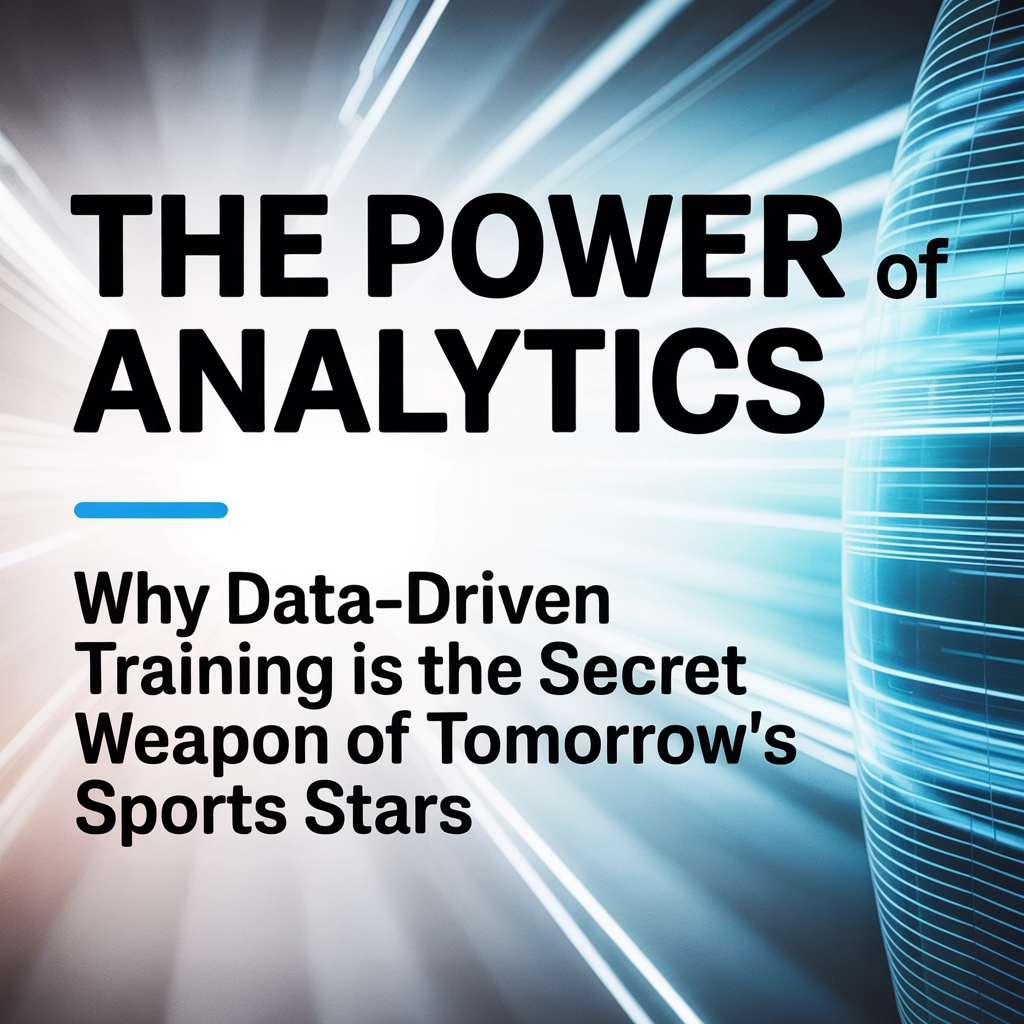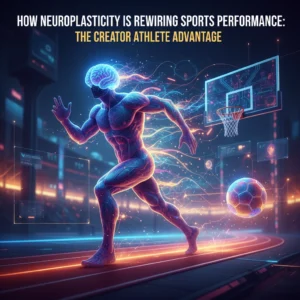The Power of Analytics: Why Data-Driven Training Is the Secret Weapon of Tomorrow's Sports Stars

The game has changed. While traditional athletes relied on gut instinct and old-school coaching methods, today's elite performers are leveraging something far more powerful: data. Every sprint, every swing, every strategic decision is now backed by analytics that reveal patterns invisible to the naked eye.
Welcome to the era of data-driven athletics, where numbers don't lie and performance optimization reaches levels that were once considered impossible. For creator athletes looking to make their mark in professional sports, understanding this analytical revolution isn't just an advantage: it's absolutely essential.
The Analytics Revolution: Beyond Basic Stats
Gone are the days when sports analytics meant tracking simple metrics like batting averages or yards per game. Today's data-driven training incorporates everything from biomechanical analysis to neurological response patterns, creating a comprehensive picture of athletic performance that's both fascinating and game-changing.
Modern sensors can track micro-movements in real-time, measuring force distribution across an athlete's foot during a sprint, or analyzing the precise angle of a golf club at impact. This level of detail allows coaches to identify inefficiencies that shave milliseconds off performance: and in elite sports, milliseconds determine champions.

What makes this particularly exciting for creator athletes is accessibility. The same technology that powers professional teams is becoming available to individual athletes and smaller training programs. Smart wearables, mobile apps, and cloud-based analytics platforms are democratizing data-driven training in ways that would have seemed impossible just a decade ago.
Personalized Performance: Your Data, Your Edge
The most powerful aspect of analytics-driven training is personalization. Every athlete's body responds differently to stimuli, recovers at different rates, and has unique strengths and weaknesses. Data analytics reveals these individual patterns with remarkable precision.
Consider two sprinters with identical 100-meter times. Traditional training might put them through the same program, but analytics reveals that one athlete excels through longer stride length while the other dominates with faster turnover rate. This insight completely transforms their training approach, allowing each athlete to maximize their natural advantages while addressing specific limitations.
Heart rate variability, sleep quality, nutrition absorption, and even stress hormone levels can now be monitored continuously. This creates a holistic view of performance that extends far beyond practice sessions. Athletes learn to optimize their entire lifestyle around peak performance windows, timing intense training when their bodies are primed for maximum adaptation.
The psychological benefits are equally impressive. When athletes can see concrete evidence of their improvement through data visualization, motivation skyrockets. Numbers provide objective validation that subjective feelings often miss: particularly important for creator athletes transitioning from content creation to serious athletic competition.
Real-Time Optimization: Instant Feedback Loops
Perhaps the most revolutionary aspect of modern sports analytics is real-time feedback. Athletes no longer need to wait for video review sessions or coaching analysis to understand their performance. Immediate data streams allow for instant adjustments that can dramatically accelerate improvement.
Imagine a tennis player practicing their serve with sensors that provide instant feedback on racket speed, ball spin rate, and contact point accuracy. Each serve becomes a learning opportunity, with precise data guiding micro-adjustments that compound into significant improvement over time.

This real-time capability extends to game situations. Basketball players can receive instant feedback on shooting mechanics during practice, while soccer players get data on their first touch, passing accuracy, and positioning decisions. The learning curve becomes exponentially steeper when feedback is immediate rather than delayed.
For creator athletes, this represents a massive opportunity to compress traditional development timelines. While conventional wisdom suggests it takes years to develop elite-level skills, data-driven training with real-time feedback can dramatically accelerate this process.
Injury Prevention: The Crystal Ball Effect
One of the most valuable applications of sports analytics is injury prevention. Advanced monitoring systems can detect subtle changes in movement patterns, muscle activation, and recovery metrics that predict injury risk before symptoms appear.
Load management has become a science unto itself. By tracking training intensity, volume, and recovery markers, analytics can determine optimal training loads that maximize adaptation while minimizing injury risk. This is particularly crucial for creator athletes who may be rapidly increasing training intensity as they transition into serious competition.
Biomechanical analysis reveals compensation patterns that often precede injury. An athlete might unconsciously favor one leg due to minor fatigue, creating stress patterns that could lead to injury weeks later. Analytics catches these issues early, allowing for corrective interventions that keep athletes healthy and performing.
Sleep analytics, stress monitoring, and nutrition tracking provide additional layers of injury prevention. When the data shows elevated stress hormones or poor sleep quality, training loads can be adjusted accordingly. This proactive approach keeps athletes in their optimal performance zone while avoiding the burnout and overtraining that sideline so many promising careers.
Strategic Advantages: The Mental Game Meets Mathematics
Analytics doesn't just optimize physical performance: it revolutionizes strategic thinking. Every opponent, every game situation, and every tactical decision can be analyzed through data that reveals hidden patterns and opportunities.
Tennis players can study their opponents' serving patterns, identifying tendencies in high-pressure situations. Golfers can analyze course conditions, wind patterns, and their own performance under different scenarios to optimize strategy. Combat sports athletes can study timing patterns, defensive reactions, and energy expenditure to plan their tactical approaches.

The strategic applications extend beyond individual performance to team dynamics and coaching decisions. Analytics can identify optimal lineups, predict performance under different conditions, and even model the psychological impact of various strategic choices.
For creator athletes entering established sports, this analytical approach can level the playing field against competitors who've been training for years. While traditional athletes rely on intuition and experience, data-driven athletes can identify and exploit patterns that others miss entirely.
The Technology Stack: Tools of Tomorrow's Champions
Modern sports analytics relies on an impressive array of technologies working in harmony. Wearable sensors track movement, force, and physiological responses. Video analysis systems break down technique with frame-by-frame precision. Environmental sensors monitor training conditions, while mobile apps collect subjective data on how athletes feel.
Machine learning algorithms identify patterns in this data that human coaches might miss. Predictive models forecast performance trends and injury risks. Cloud computing makes sophisticated analysis accessible from anywhere, while mobile interfaces put insights directly in athletes' hands.
The integration of these technologies creates synergies that multiply their individual benefits. When sleep data, training load, and performance metrics are analyzed together, the insights become exponentially more valuable than any single data stream alone.
The Creator Athlete Advantage
For creator athletes, the analytics revolution represents an unprecedented opportunity. Traditional athletic development pathways often require years of institutional training and gradual progression through established systems. Data-driven training compressed these timelines while providing insights that can accelerate development in remarkable ways.
Creator athletes often bring unique advantages to this analytical approach. Their comfort with technology, data interpretation, and systematic optimization translates naturally to sports analytics. The same mindset that drives content optimization and audience analytics can be applied to athletic performance with impressive results.
The crossover between content creation and athletic performance analytics is particularly fascinating. Understanding engagement metrics, audience behavior, and content performance provides excellent preparation for interpreting sports performance data. Many of the analytical thinking patterns transfer directly between domains.
Building Your Analytics Foundation
Getting started with data-driven training doesn't require massive investments in expensive equipment. Many powerful analytics tools are now accessible through smartphone apps and affordable wearables. The key is starting with basic metrics and gradually building more sophisticated analysis capabilities.
Focus first on establishing consistent data collection habits. Whether tracking heart rate during workouts, logging sleep patterns, or recording training loads, consistency creates the foundation for meaningful analysis. Even simple metrics become powerful when tracked systematically over time.
As your analytical capabilities grow, invest in more sophisticated tools and professional guidance. Working with coaches who understand sports analytics amplifies the benefits exponentially. The combination of human expertise and data insights creates optimization opportunities that neither approach achieves alone.
The Future of Athletic Excellence
We're still in the early stages of the analytics revolution in sports. Artificial intelligence, advanced biomechanical modeling, and even more sophisticated sensors promise to unlock insights we can't yet imagine. Athletes who embrace this analytical approach now will be positioned to benefit from future developments as they emerge.
The democratization of sports analytics means that individual athletes and smaller programs can access tools that were once exclusive to professional organizations. This levels the playing field in unprecedented ways, creating opportunities for creator athletes to compete at the highest levels without traditional institutional backing.
Data-driven training isn't just changing how athletes train: it's redefining what's possible in human performance. For creator athletes ready to embrace this analytical revolution, the opportunities are limitless.
Ready to transform your athletic potential through data-driven training? Discover how Creator Athlete's comprehensive approach combines cutting-edge analytics with proven performance strategies. Contact us to start your journey from creator to champion.






